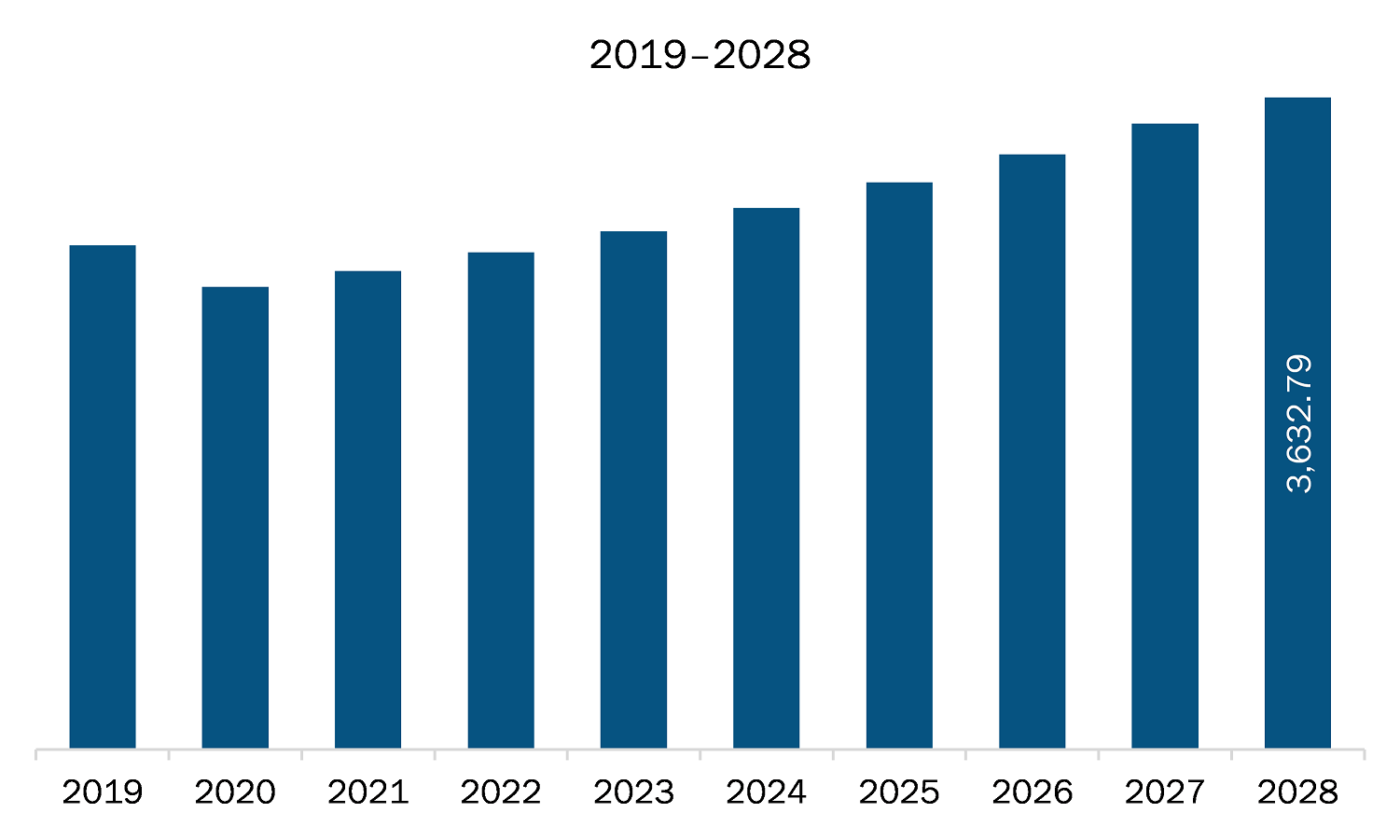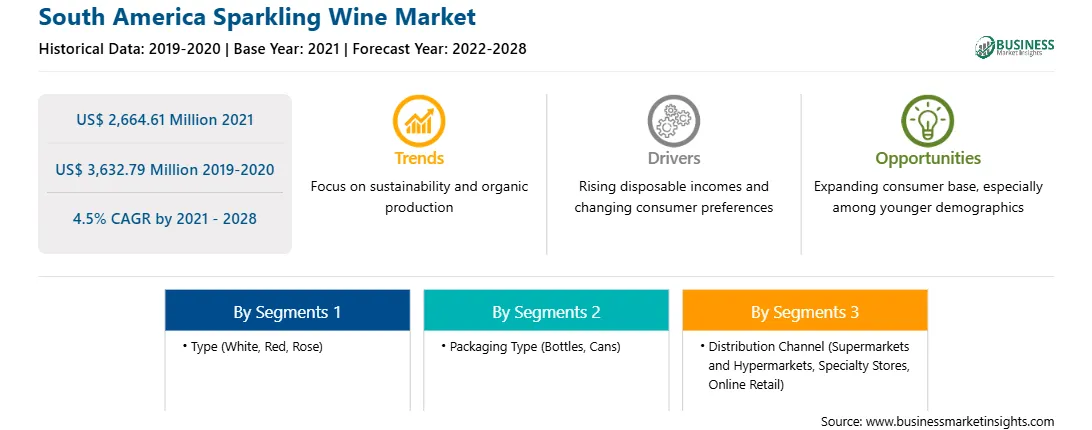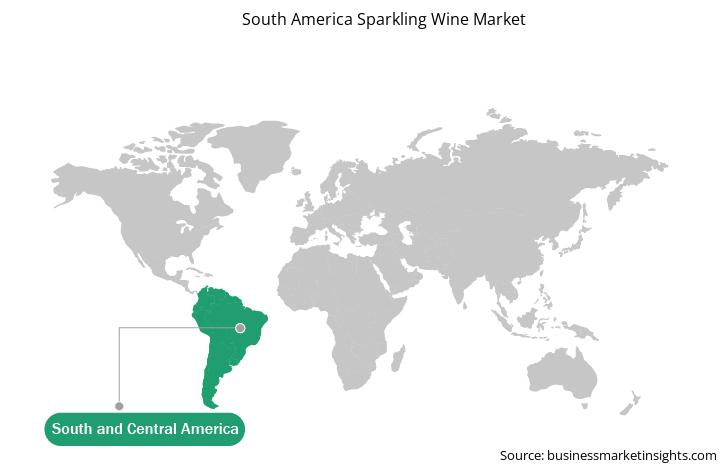The South American sparkling wine market is segmented into Brazil, Argentina, and the Rest of South America. The region holds high potential for the market as sparkling wines and Champagne are consumed in large quantities. The sparkling wine market across the region is mainly driven by the factors such as the availability of high-quality sparkling wine, different manufacturing techniques, and the existence of a long sparkling winemaking tradition. Argentina, Chile, Brazil, and Uruguay have created their own sparkling wine styles, based on local tastes and preferences, holding Champagne as a reference. This has made the domestic sparkling wine varieties highly popular across the region, and they are gaining popularity across the world. Moreover, South American countries have a tropical climate, which is highly favorable for growing grapes. In tropical Brazil, high-quality wine grapes are cultivated. In addition to this, substantial economic development, improving lifestyles, changing customer preferences, and rising disposable income levels are favoring the growth of the sparkling wine market in South America. Increase in popularity of sparkling wine is the major factor driving the growth of the SAM sparkling wine market.
The country with the most confirmed COVID-19 cases in South America was Brazil, followed by Argentina, Peru, Chile, and Ecuador. Governments across the region have implemented several preventive measures to protect their residents and limit the spread of the novel coronavirus. Limitations on operations of various industries across the region have adversely affected the demand for sparkling wine, which is further expected to restrain the growth of sparkling wines market in South America.

Strategic insights for the South America Sparkling Wine provides data-driven analysis of the industry landscape, including current trends, key players, and regional nuances. These insights offer actionable recommendations, enabling readers to differentiate themselves from competitors by identifying untapped segments or developing unique value propositions. Leveraging data analytics, these insights help industry players anticipate the market shifts, whether investors, manufacturers, or other stakeholders. A future-oriented perspective is essential, helping stakeholders anticipate market shifts and position themselves for long-term success in this dynamic region. Ultimately, effective strategic insights empower readers to make informed decisions that drive profitability and achieve their business objectives within the market.

| Report Attribute | Details |
|---|---|
| Market size in 2021 | US$ 2,664.61 Million |
| Market Size by 2028 | US$ 3,632.79 Million |
| Global CAGR (2021 - 2028) | 4.5% |
| Historical Data | 2019-2020 |
| Forecast period | 2022-2028 |
| Segments Covered |
By Type
|
| Regions and Countries Covered | South and Central America
|
| Market leaders and key company profiles |
The geographic scope of the South America Sparkling Wine refers to the specific areas in which a business operates and competes. Understanding local distinctions, such as diverse consumer preferences (e.g., demand for specific plug types or battery backup durations), varying economic conditions, and regulatory environments, is crucial for tailoring strategies to specific markets. Businesses can expand their reach by identifying underserved areas or adapting their offerings to meet local demands. A clear market focus allows for more effective resource allocation, targeted marketing campaigns, and better positioning against local competitors, ultimately driving growth in those targeted areas.

The sparkling wine market in SAM is expected to grow from US$ 2,664.61 million in 2021 to US$ 3,632.79 million by 2028; it is estimated to grow at a CAGR of 4.5% from 2021 to 2028. The increasing practice of consuming vintage wine on special occasions and surge in the acceptance of wine are the key factors supporting the expansion of the sparkling wines market in economies such Argentina and Chile. For instance, wine consumption in Argentina has risen steadily in the 21st century due to high popularity and availability of sparkling wine varieties, especial through online retail channels. The country is also scaling up its domestic wine production. Its vineyard acreage more than doubled during 2006–2016. While most of that land is being utilized for growing table grapes, wine production is gradually increasing. Moreover, international winemakers are seeking entry into the market, and they are altering their winemaking styles and adjusting their packaging designs to appeal to the local consumers. The rising consumption of grape wine is also providing opportunities for the local manufacturers. People have started adopting the tradition of popping champagne corks on special events such as completing new deals, earning large profits, corporate parties, and weddings and receptions. This has resulted in the expansion of the sparkling wine market in the country. Thus, several countries are providing enormous opportunities for the sparkling wines market players across SAM region.
The SAM sparkling wine market is segmented on the bases type, packaging type, and distribution channel, and country. Based on type, the market is segmented into white, red, and rose. The white segment dominated the market in 2020 and red segment is expected to be the fastest growing during the forecast period. On the basis of packaging type, the sparkling wine market is segmented into bottles and cans. The bottles segment dominated the market in 2020 and cans segment is expected to be the fastest growing during the forecast period. On the basis of distribution channel, the sparkling wine market is segmented into supermarkets and hypermarkets, specialty stores, online retail, and others. The supermarkets and hypermarkets segment dominated the market and online retail segment is expected to be the fastest growing during the forecast period.
A few major primary and secondary sources referred to for preparing this report on the sparkling wine market in SAM are company websites, annual reports, financial reports, national government documents, and statistical database, among others. Major companies listed in the report are Bacardi and Company Limited; Chandon; Constellation Brands, Inc.; Henkell Freixenet; and Treasury Wine Estates Ltd are among others.
The South America Sparkling Wine Market is valued at US$ 2,664.61 Million in 2021, it is projected to reach US$ 3,632.79 Million by 2028.
As per our report South America Sparkling Wine Market, the market size is valued at US$ 2,664.61 Million in 2021, projecting it to reach US$ 3,632.79 Million by 2028. This translates to a CAGR of approximately 4.5% during the forecast period.
The South America Sparkling Wine Market report typically cover these key segments-
The historic period, base year, and forecast period can vary slightly depending on the specific market research report. However, for the South America Sparkling Wine Market report:
The South America Sparkling Wine Market is populated by several key players, each contributing to its growth and innovation. Some of the major players include:
The South America Sparkling Wine Market report is valuable for diverse stakeholders, including:
Essentially, anyone involved in or considering involvement in the South America Sparkling Wine Market value chain can benefit from the information contained in a comprehensive market report.